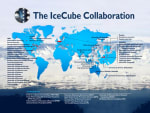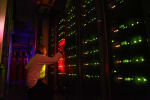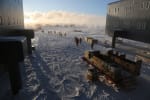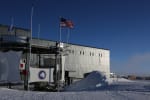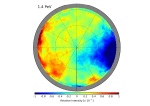The IceCube spring 2016 meeting begins today at Stony Brook University. Assistant Professor Joanna Kiryluk is hosting the weeklong meeting at the Charles B. Wang Center. Pre-meetings were held at Columbia University in New York on April 16-18. […]
News
Week 13 at the Pole
It was a relatively tranquil week at the Pole, but not without its interruptions—April Fool’s Day pranks among them. The waning light in the sky is beginning to lend a little eeriness to photos. […]
Week 12 at the Pole
A mushroom cloud … at the South Pole? What’s going on down there? What’s going on is actually a rising full moon getting distorted by the atmosphere. Pretty cool image. […]
Week 11 at the Pole
With so little time left above the horizon, the sun is making a nice spectacle of itself at the South Pole. Here we see it bright and orange and surrounded by a clear halo as it hovers above the satellite stations. […]
NSF renews IceCube maintenance and operations contract
The National Science Foundation today, March 30, 2016, announced that it has renewed a cooperative agreement with the University of Wisconsin–Madison to operate IceCube. The five-year, $35 million award entails the continued operation and management of the observatory located at NSF’s Amundsen-Scott South Pole Station. In 2013, the IceCube Collaboration reported the first detection of high-energy cosmic neutrinos, opening a new astronomical vista on the universe and on some of its most violent phenomena. […]
Week 10 at the Pole
Last week there were a few alarm calls in the cryo building. The first one interrupted an outreach webcast, and then there was another one later the same day. The photo shows the emergency response team on their return from one of those calls. You can see that the sun is still out, just a few degrees above the horizon. […]
Week 9 at the Pole
On a clear sunny day, it’s easy to make out the buildings at the end of the road to the Dark Sector, but the flag line is set up for the winter months, when darkness and extreme temperatures reign and you really can’t afford to get lost out there. […]
Over 200 high school students joined the 2016 IceCube Masterclass
The third edition of the IceCube Masterclass hosted over 200 students at 10 institutions in Belgium, Germany, and the US. Madison (WI) hosted the first edition in Spanish, attended by 28 Hispanic high school students. Masterclasses were held on March 2 and March 9. […]
Week 8 at the Pole
There’s a beautiful half moon in this image, can you spot it? Well, it is a little small in the photo—but sometimes we don’t notice the moon out during the day because we’re not expecting it. However, we shouldn’t be surprised see it then, since it’s often visible. […]
A closer look at the cosmic ray anisotropy with IceCube
The IceCube Collaboration is updating the cosmic ray anisotropy maps using 318 billion cosmic-ray-induced muon events detected in IceCube between May 2009 and May 2015. The larger data sample allowed discerning new regions in the anisotropy maps, which shed some light on the physical processes that stir up the variations in the arrival direction of cosmic rays. These results have been recently submitted to The Astrophysical Journal. […]
